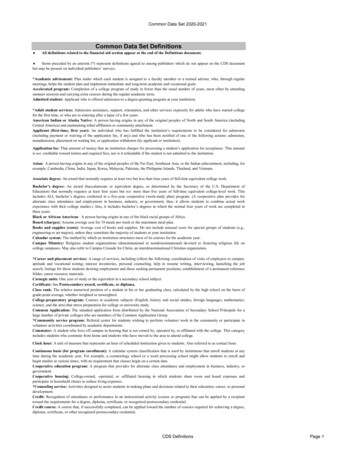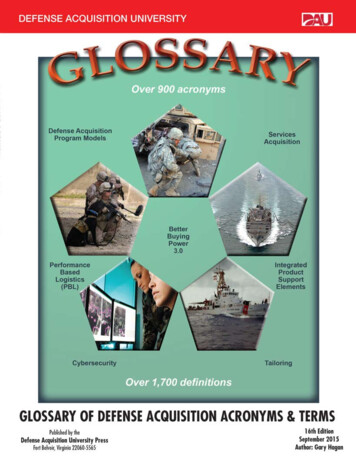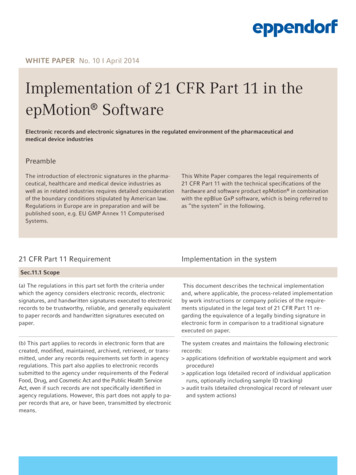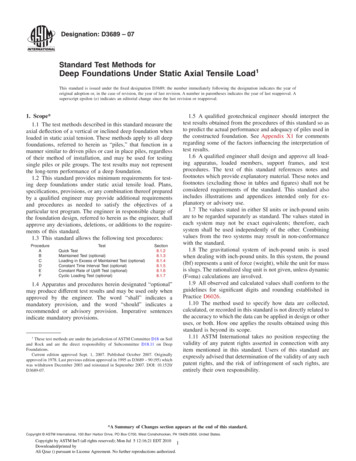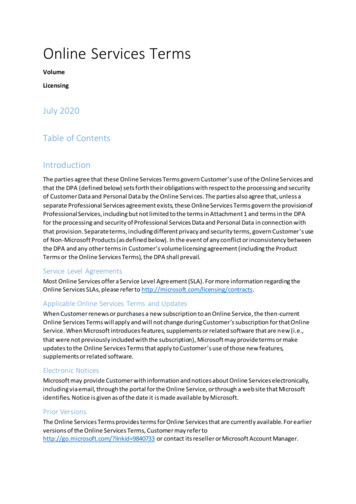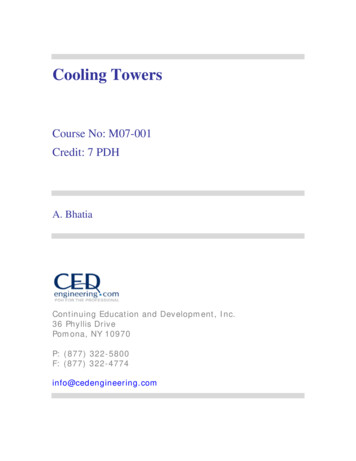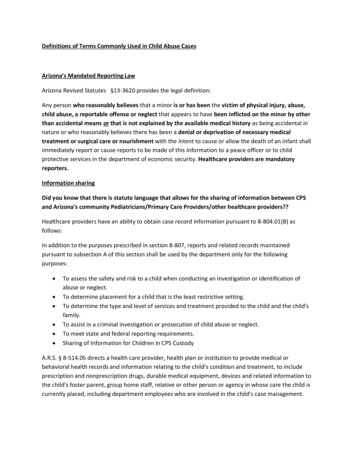
Transcription
Definitions of Terms Commonly Used in Child Abuse CasesArizona’s Mandated Reporting LawArizona Revised Statutes §13-3620 provides the legal definition:Any person who reasonably believes that a minor is or has been the victim of physical injury, abuse,child abuse, a reportable offense or neglect that appears to have been inflicted on the minor by otherthan accidental means or that is not explained by the available medical history as being accidental innature or who reasonably believes there has been a denial or deprivation of necessary medicaltreatment or surgical care or nourishment with the intent to cause or allow the death of an infant shallimmediately report or cause reports to be made of this information to a peace officer or to childprotective services in the department of economic security. Healthcare providers are mandatoryreporters.Information sharingDid you know that there is statute language that allows for the sharing of information between CPSand Arizona's community Pediatricians/Primary Care Providers/other healthcare providers?Healthcare providers have an ability to obtain case record information pursuant to 8-804.01(B) asfollows:In addition to the purposes prescribed in section 8-807, reports and related records maintainedpursuant to subsection A of this section shall be used by the department only for the followingpurposes: To assess the safety and risk to a child when conducting an investigation or identification ofabuse or neglect.To determine placement for a child that is the least restrictive setting.To determine the type and level of services and treatment provided to the child and the child'sfamily.To assist in a criminal investigation or prosecution of child abuse or neglect.To meet state and federal reporting requirements.Sharing of Information for Children in CPS CustodyA.R.S. § 8-514.05 directs a health care provider, health plan or institution to provide medical orbehavioral health records and information relating to the child's condition and treatment, to includeprescription and nonprescription drugs, durable medical equipment, devices and related information tothe child's foster parent, group home staff, relative or other person or agency in whose care the child iscurrently placed, including department employees who are involved in the child's case management.
What is Neglect?The legal definition – Arizona Revised Statutes §8-802(22)Neglect is defined as a determination by a health professional that a newborn was exposed prenatally toa drug or substance listed in section 13-3401 and that this exposure was not the result of a medicaltreatment administered to the mother or the newborn infant by a health profession.The determination by the health professional is to be based on clinical indicators in the prenatal periodincluding maternal and newborn presentation’ history of substance use or abuse; medical history; andthe results of a toxicology or other laboratory test on the mother or the newborn infant.NeglectA good clinical definition of Neglect is from Pediatrics. Dec 2007;120(6): 1385-1389 A child is harmed or is at risk of harm because of lack of health care; The recommended health care offers significant net benefit to the child; The anticipated benefit of the treatment is significantly greater than its morbidity, so thatreasonable caregivers would choose treatment over non-treatment; It can be demonstrated that access to health care is available and not used; and The caregiver understands the medical advice given.The Substance-Exposed NewbornHow does the Substance-Exposed Newborn fit into the Neglect definition?Arizona Revised Statutes §13-3620Requires a health care professional, who reasonably believes that a newborn infant may be affected bythe presence of alcohol or a drug, to immediately report this information, or cause a report to be made,to Child Protective Services. For reporting purposes, "newborn infant" means a newborn infant who isunder thirty days of age. Healthcare providers are mandatory reporters.The federal Child Abuse and Prevention Treatment Act (CAPTA) at section 106(b)(2)(B)(ii) requires healthcare providers to notify CPS of all infants born and identified as affected by illegal substance abuse.Arizona Revised Statutes §8-802(22) Neglect is defined as a determination by a health professional that a newborn was exposedprenatally to a drug or substance listed in section 13-3401 and that this exposure was not the
result of a medical treatment administered to the mother or the newborn infant by a healthprofession. The determination by the health professional is to be based on clinical indicators in the prenatalperiod including maternal and newborn presentation’ history of substance use or abuse;medical history; and the results of a toxicology or other laboratory test on the mother or thenewborn infant.The following two elements must be present to prove neglect involving SEN:1. A determination by a health professional that a newborn infant was exposed prenatally to adrug or substance listed in A.R.S. § 13-3401. This determination must be based on one or moreof the following:a) Clinical indicators in the prenatal period including maternal and newborn presentation;b) The mother’s history of substance use or abuse;c) The medical history pertaining to the pregnancy; and/ord) The results of toxicology or other laboratory tests on the mother or newborn infant.2.That the prenatal drug exposure was not the result of a medical treatment administered to themother or newborn infant by a health professional.Fetal Alcohol ExposureFetal Alcohol Syndrome (FAS) - a congenital medical condition, in which body deformation occurs,and/or facial development or mental ability is impaired because the mother drinks alcohol duringpregnancy.Fetal Alcohol Spectrum Disorder (FASD) - a pattern of birth defects, learning, and behavioral problemsaffecting individuals whose mothers consumed alcohol during pregnancy. Other terms under spectrumdisorder include: Alcohol-related neurodevelopmental disorder (ARND)Alcohol-related birth defects (ARBD)What is a helpful clinical definition of Physical Abuse?Child abuse is a symptom of family dysfunction which results in injury to a child.
Caregiver-Fabricated Illness (formally known as Munchausen by Proxy) refers to a form of child abuse inwhich an adult falsifies developmental, physical, and/or psychological signs and/or symptoms in a victimcausing that victim to be regarded as more ill or impaired than objective evaluation reveals them to be.Other common terminology used for this condition includes: Fabricated Illness in a Child1, Factitious Disorder Imposed on Another 2, Pediatric condition falsification, Factitious disorder (illness) by proxy, Child abuse in the medical setting, and Medical child abuse.Caregiver-Fabricated Illness consists of two components: The first component is the identification of the child abuse, the victimization of the child, calledCaregiver-fabricated Illness (which can include exaggeration, fabrication, simulation and/orinduction of symptoms). The child is receiving unnecessary and harmful or potentially harmfulmedical care at the instigation of a caretaker.3 The second component is the identification of the psychopathology of the suspectedperpetrator, called Factitious Disorder Imposed on Another.Abusive Head TraumaDid you know that Shaken Baby Syndrome is now termed Abusive Head Trauma (AHT)?In 2009, the American Academy of Pediatrics changed the terminology to account for an increasedunderstanding of the mechanisms of this type of trauma, which include4: Shaking, Blunt impact, or a Combination of forces.1Emalee G. Flaherty, MD, FAAP, and Harriet L. MacMillan, MD, and COMMITTEE ON CHILD ABUSE AND NEGLECT.Pediatrics 2013;132:590–5972DSM V, Somatic Symptom and Related Disorders, Factitious Disorder3Roesler TA, Jenny C. Medical Child Abuse: Beyond Munchausen Syndrome by Proxy. Elk Grove Village, IL:American Academy of Pediatrics; 20094Christian CW, Block R, and the Committee on Child Abuse and Neglect. Abusive Head Trauma in Infants and Children.Pediatrics 2009;123:1409-1411
Infants and young children have relatively large heads with poor neck support and are most prone tohead injuries by direct impact or shaking. Head injuries are the most common cause of death fromabuse, with infants under 1 year being at the highest risk. Most (80%) deaths from head trauma inchildren under the age of 2 are a result of abuse.All of the following injuries are consistent with Abusive Head Trauma: Retinal hemorrhages ( seen in 75% - 90% of cases), Posterior & medial rib fractures, Subdural hematomas, and/or Brain stem injury .The above clinical findings frequently show little or no evidence of external trauma. There is oftendelay in seeking medical care and a common history is that the infant “went to sleep, but didn’t wakeup”.Confessions from the perpetrators are uncommon; however, one study found that 62.5% of confessionsstated they shook the infant in an “extremely violent” manner, and repeatedly (2 to 30 times) because it“stopped the infant’s crying”.5Shaking, with or without the sudden deceleration or impact of the head and brain can cause thefollowing:5 Subdural hematoma - a collection of blood between the surface of the brain and the dura (theouter membrane covering the brain.) This occurs when the veins that bridge from the brain tothe dura are stretched beyond their elasticity, causing tears and bleeding. Subarachnoid hemorrhage is bleeding between the arachnoid (web-like membrane surroundingthe brain which is filled with spinal fluid) and the brain. Direct trauma to the brain itself when the brain tissue strikes the inner surface of the skull. Shearing off or breakage of nerve cell branches (axons) in the superficial or deeper structuresof the brain caused by violent motion to the brain. Irreversible damage to the brain tissue from the lack of oxygen if the child stops breathingduring or after shaking.Adamsbaum C, Grabar S, Mejean N, Rey-Salmon C. Abusive Head Trauma: Judicial Admissions Highlight Violent and RepetitiveShaking. Pediatrics 2010:126:546-5553 The Radiology Assistant, Non Accidental Trauma by Simon Robben, Radiology Department of the Maastricht UniversityHospital in the Netherlands
Further damage to the oxygen-deprived brain cells when the injured nerve cells releasechemicals from cell death. Acute on chronic hemorrhages - The doctors are saying that there were old (chronic) subduralbleeds from previous injury and then a new (acute) bleed from new injury. This would likelymake an infant symptomatic (lethargy, pale, then later seizures) prompting the parents to seekmedical care. Seizures may occur from abusive head trauma and the traumatic brain injury thatoccurred with this event(s).Eye Injuries – Retinal HemorrhagesThere is a correlation between the severity of brain injury and injury to the retina. Hemorrhages can bebilateral (both eyes), pre-retinal (on the surface of the retina), extensive, multilayered, extending out tothe edges of the retina (ora serrata), under the retina (subretinal), or within the retinal tissue. Aparticularly important form of hemorrhage is caused by the splitting of the retinal layers, with bloodaccumulating in this space (retinoschisis).Bone & Joint InjuriesAbused children with fractures tend to be young 5 years of age and have more than onefracture. Children have flexible bones that are more likely to bend than break – hence we see boneswith buckled cortex, or changes in the periosteum (covering of the bone).The metaphysis or wide part of the long bone next to the growth plate is susceptible to non-accidentalinjury in young children and babies. Fractures of this area are called metaphyseal corner or buckethandle fractures and are highly associated with child abuse. Fractures of the metaphysis are thought tohappen when the baby has been pulled or swung violently from an arm or leg and the relatively weakergrowing point of the bone breaks. There may be no outer sign of a fracture.In general, classic metaphyseal lesions (CML) or fractures are quite concerning and have the highestspecificity in infants & toddlers and are not consistent with fractures from play or even brittle bonedisease. Digital fractures (fingers/toes) are of moderate specificity for child abuse.Rib fractures have a strong association with non-accidental trauma (NAT) and severe trauma. 6 Severalstudies have made very strong statements about the association of posterior rib fractures and abuse.Even in the setting of cardiopulmonary resuscitation (CPR), posterior rib fractures are highly suggestiveof abuse, as the ribs tend to bend before they break.6Barsness KA, et al. The positive predictive value of rib fractures as an indicator of nonaccidental trauma inchildren. J Trauma. 2003 Jun;54(6):1107-10.
Child abuse should be considered in cases of pediatric rib fractures, particularly fracture of the first rib.One study out of Ann Arbor, Michigan demonstrated that first rib fractures (in the absence of bonedisease) were most likely to be the result of child abuse. Proposed mechanisms for first-rib fractureinclude impact force, compressive force, and shaking or acute axial load (force generated up the spine)from slamming the infant down.7Specificity of X-Ray Findings in Infants & Toddlers for Child Abuse8High Specificity for child abuse,especially in infantsClassic metaphyseal lesions or fractures (CML)Rib fractures, especially in the back & side of the ribsFractures of the scapula bone on the backFractures of the spinous process on the back boneFractures of the chest bone (sternum)Moderate specificity for child abuseMultiple fractures, especially bilateral (on both sides of body)Fractures of different agesEpiphyseal (growth plate) separationsVertebral body fractures & subluxations (back bone fractures)Fractures of finger bonesComplex skull fractures (more than one fracture in more thanone skull bone)Common fractures, but low specificityfor abuseNew bone formation under the bone covering (subperiosteum)Fractures of the clavicle (collar bone)Fractures of the long bones (arm & leg bones)Linear skull fractures (straight, simple skull fractures)Subluxation is a partial dislocation of a jointSynovitis is inflammation of the joint liningNeck ligamentous strain - due to abnormality of the left posterior intraoccipital synchondrosis.(Translation cartilaginous union between the squamous and lateral parts of the occipital bone in thenewborn). May be seen in aggressive acceleration/deceleration injuries.Osteogenesis Imperfecta (OI) is a congenital bone disorder which means that it is present at birth. It ischaracterized by brittle bones that are prone to fracture. People with OI are born with defectiveconnective tissue caused by genes that don’t work properly. There is a deficiency of Type-I collagenwhich is an important building material for healthy bones.78Strouse PJ, Owings CL. Fractures of the first rib in child abuse. Radiology. 1995 Dec;197(3):763-5.Pediatrics Volume 133, Number 2, Feb 2014
The diagnosis of OI is based on the clinical features and may be confirmed by collagen or DNA testing. OIcan range from mild to severe and symptoms vary from person to person. To date, eight types of OIhave been recognized.In most cases, we are unable to establish exact timelines for fractures and other non-accidental injuries.Depending on the X-Ray findings, we can sometimes state that the fractures are of different stages ofhealing, therefore happened during different times. The follow up skeletal survey will also show us ifthere were relatively new fractures at the time of the hospital admission that could not be visualized onthe original X-rays. As the bone heals, it makes a callous formation to mend the 2 pieces of the bonetogether. At that time, the healing fracture because of the callous formation may be more visible on theX-Ray.Malnutrition and Failure to ThriveCachexia means that the patient has severe wasting affecting weight and body mass. This puts a patientat significant risk of death as the body does not have the fuel it needs to sustain life or fight infection.Failure to Thrive (FTT) – is abnormal weight age or weight gain in a child younger than 2 years of age.The growth chart shows that the weight has crossed over 2 major percentiles from where the child hadbeen growing. Also defined as:-Weight 3rd% or 5th%-Weight 80th% of ideal weight for ageFTT describes a sign, not a diagnosis. It is a failure to gain weight that is disproportionate (involvesweight more than height). There is no obvious cause. It is a diagnosis of infants & young children - 2years of age who are unable to get food and fend for themselves. It is a condition caused by inadequatecaloric intake or inadequate caloric absorption or excessive metabolic demand.When starvation becomes severe, not only weight will be compromised, but also height AND headgrowth. Head growth is a reflection of brain growth and is usually spared in FTT unless it is severe andprolonged. The first growth parameter to fall off is weight, followed by height, and finally by brain size.FTT can be secondary to abuse or neglect and is most often seen in families with significant dysfunction,stress, and/or substance abuse.Severe malnutrition may cause immune dysfunction and the baby will not be able to fight off infectionor tolerate any minor stress to her body (e.g., environmental heat or cold stress). SevereFTT/malnutrition will ultimately lead to death.
Definitions of Terms Commonly Used in Child Abuse Cases Arizona's Mandated Reporting Law Arizona Revised Statutes §13-3620 provides the legal definition: Any person who reasonably believes that a minor is or has been the victim of physical injury, abuse, child abuse, a reportable offense or neglect that appears to have been inflicted on the minor by other

